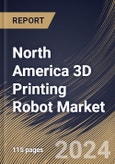In recent years, the convergence of robotics and 3D printing technologies has given rise to the market. This dynamic sector stands at the forefront of technological innovation, offering a paradigm shift in manufacturing processes across various industries. As industries seek enhanced precision, efficiency, and customization, 3D printing and robotics marriage presents a transformative force that reshapes traditional manufacturing landscapes.
Additionally, the adoption of these robots has witnessed a rapid ascent, driven by their ability to redefine traditional manufacturing methods. Organizations are progressively incorporating these state-of-the-art technologies into various sectors, including aerospace, healthcare, automotive, and others, to obtain a competitive advantage. The adaptability and versatility of these robots have significantly influenced their pervasive adoption.
The construction sector in the United States has been witnessing a wave of innovation, and these robots have emerged as a disruptive technology with the potential to transform traditional construction methods. According to the United States Census Bureau data, the seasonally adjusted annual rate of construction expenditures for November 2023 was projected to be $2,050.1 billion, representing an increase of 0.4 percent (±1.0 percent) over the revised estimate from October of $2,042.5 billion. Moreover, Canada's growing food and beverage sector, known for its culinary diversity and innovation, may leverage these robots to create novel and artistic culinary creations. As per Statistics Canada, in 2022, the food and beverage processing industry was the largest manufacturing industry in Canada in terms of the value of production, with sales of goods manufactured worth $156.5 billion; it accounted for 18.2% of total manufacturing sales and 1.7% of the national Gross Domestic Product (GDP). Thus, the growing construction and culinary sectors in North America region will drive the market growth.
The US market dominated the North America 3D Printing Robot Market by Country in 2022, and would continue to be a dominant market till 2030; thereby, achieving a market value of $1,083.2 million by 2030. The Canada market is experiencing a CAGR of 16.6% during (2023 - 2030). Additionally, The Mexico market would exhibit a CAGR of 15.6% during (2023 - 2030).
Based on Component, the market is segmented into Robot Arms, 3D Printing Heads, and Software. Based on Application, the market is segmented into Prototyping, Tooling, and Functional Part Manufacturing. Based on Robot Type, the market is segmented into Articulated Robots, Cartesian Robots, Scara Robots, Polar Robots, Delta Robots, and Others. Based on End User, the market is segmented into Aerospace & Defense, Construction, FMCG, Culinary, Automotive, and Others. Based on countries, the market is segmented into U.S., Mexico, Canada, and Rest of North America.
List of Key Companies Profiled
- Kuka AG (Midea Group Co., Ltd.)
- ABB Group
- Yaskawa Electric Corporation
- FANUC Corporation
- Universal Robots A/S (Teradyne, Inc.)
- Massive Dimension
- CEAD B.V.
- Caracol
- Meltio3D
- Comau S.p.A. (Stellantis N.V.)
Market Report Segmentation
By Component- Robot Arms
- 3D Printing Heads
- Software
- Prototyping
- Tooling
- Functional Part Manufacturing
- Articulated Robots
- Cartesian Robots
- Scara Robots
- Polar Robots
- Delta Robots
- Others
- Aerospace & Defense
- Construction
- FMCG
- Culinary
- Automotive
- Others
- US
- Canada
- Mexico
- Rest of North America
Table of Contents
Companies Mentioned
- Kuka AG (Midea Group Co., Ltd.)
- ABB Group
- Yaskawa Electric Corporation
- FANUC Corporation
- Universal Robots A/S (Teradyne, Inc.)
- Massive Dimension
- CEAD B.V.
- Caracol
- Meltio3D
- Comau S.p.A. (Stellantis N.V.)
Methodology

LOADING...








